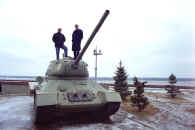
Volgograd -- Stalingrad March, 2001

We were in Vienna in December, having a drink with Peter Craig from London. Peter is a history buff, and we were comparing notes about various books on WWII which have come out over the last few years -- Keegan's wonderful history of the war, Alan Clark's history of the war on the Eastern front, Beevor's book on the Battle of Stalingrad . .
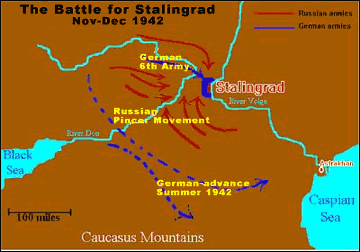
Peter said "I have always dreamed about seeing Stalingrad, Mamaev Hill, the department store where Paulus surrendered . . ." * Peter is over 50 and grew up in the Cold War, and so Stalingrad seemed like an impossibly exotic and inaccessible place. But of course that is no longer the case. Stalingrad is now called Volgograd, and is just a couple of hours from Moscow by plane. So a plan was hatched . . .
* The Battle of Stalingrad was, of course, the bloodiest battle of World War II, the turning point of the war, and one of the bloodiest battles of all time. Over a million Russians died and the German Sixth Army was annihilated.
*******
Peter arrived one Thursday from London, and I took him to Tiflis, the wonderful Georgian restaurant near our building on Ostozhenka Street.
The next day he, Yegor, and I fly off to Volgograd. Or attempt to fly off to Volgograd. Friday afternoon is traffic hell in Moscow, and this day it is snowing, and so double traffic hell. We stand in gridlock for hours and miss the Aeroflot flight, by a few minutes. The next flight is some hours later and from Domodyedovo Airport, all the way across the city and way the hell out of town in the other direction. We try to take this "philosophically", as the Russians would say, buy six cans of ready-mixed gin tonics, pile back into the car, and make our way back through the traffic into the city. We make the next flight without a hitch. Despite our apprehension about flying on a no-name, fly-by-night regional airline (Russia's airlines are all private now, and there are several dozen of them), on a Yak 42, we arrive safely at Volgograd Airport. This is a typical Soviet-style airport (a stark contrast to gleaming, modern, Domodyedovo, which could be any recently renovated European airport). Buses take us off the plane and to a "gate" which is just a gap in the fence; we do not pass through the building at all.
We walk through this and run the gauntlet of taxi drivers trying to gouge a fare. Lengthy negotiations fail to result in what we consider a reasonable fare, and so we hitch a ride on a "marshrutka" -- a Gazelle van which runs a particular route around the city. For an extra negotiated fee, the driver agrees to take us right to our hotel.
The hotel is a typical Stalin-era better-class hotel aimed at visiting functionaries and foreign tourists; built in a pompous fascist neo-classic style. It is not in very good repair, but is incredibly clean. It is right on the city's main square, and our windows look out onto the famous department store where Paulus surrendered . . .
On Saturday, we meet Pavel, the owner of a local appraisal company and brokerage firm. Pavel picks us up and takes us to his office, and we hear all about what the market is like in Volgograd, what kind of work he does, etc. He is a protege of our friend Gere Gaige from Arthur Andersen, who lived in the these parts a few years ago teaching courses on appraisal on a World Bank project. We are surprised at how well developed the market is in Volgograd. And Pavel does highly professional appraisals; Gere did his work well.
So off we go to see a bit of the city.
Pavel, Peter, Yegor getting geared up.
Lunch at a cafe near the waterfront (near the famous statue of dancing girls).
We are about to undertake the outdoor portion of our tour, and Pavel insists that we should be fortified against the cold. So we buy a bottle of Dagestani cognac and pour it into our coffee.
Yegor looks at the famous cotton mill, one of the only buildings left standing in Stalingrad after the intense house-to-house fighting.
Yegor and I stand on a T34 tank. The Volga is in the background.
Yegor stands in front of an Austrian pillbox on Mamaev Hill. This place was deserted and eerie. The famous monument is not on the summit of Mamaev Hill itself, but off to one side where the earth was built up artificially.
The historical museum in Volgograd.
The lobby of the historical museum, a surprisingly beautiful building.
Yegor in front of the cotton mill. The historical museum is half-hidden behind the mill.
Historical museum.
Yegor admires (and identifies at length) artifacts in the historical museum.
Peter, Yegor, myself in front of Rodina-Mat' (Motherland-Mother), an enormous monument twice the height of the Statue of Liberty.
Mother Russia screams and holds a sword in defiance of her enemies. If you look closely, you will see the bottle of Dagestani cognac in Yegor's hand (I pressed it on him just before the photo was snapped). I think Peter was horrified that we were drinking Dagestani cognac out of the neck of the bottle in broad daylight in public.
Yegor explains troop movements around Mamaev Hill during the battle.
The monument at soldiers' field, a desolate and eerie place.
The streets of Volgograd in March.
Austrian pillbox. Just behind this is the place where a mass grave of Austrians was found; the pit is still open.
Mamaev Hill.
In the evening, we reconvene at the hotel.
Peter, Pavel and Yegor in the lobby of the Hotel Volgograd.
Then we go to the municipal banya to partake in an ancient Russian tradition. The bath attendant is a hunchback; he runs all over wearing nothing but a sheet draped around his twisted torso, making sure no one gets into the pool without a shower, and that no one stays too long in the steam room, scolding as necessary. The presence of the hunchback adds a slightly surrealistic aspect to the experience. We switch from Dagestani cognac to vodka and beer. The steam room is crowded; it's Saturday evening -- prime time. Pavel passes out prized oak "brooms" -- he makes them himself or buys them at the market -- for people to beat each other with, an essential part of the procedure, designed to get the blood flowing. Strangers beat each other with the oak brooms, but taking me for a Muscovite of unknown delicacy, no one is eager to beat me. Then Pavel reveals that I'm not a Muscovite at all, but an American. Ah, that's different, someone says. "Amerikanets -- pochti kak Russky muzhik". An American -- almost like a Russian muzhik. So I get the treatment after all; and following that, a cold plunge (if we were in the country, it would be a naked roll in the snow, as we did at Gennady Petrovich's a couple weeks ago) and then more steam. Indeed, the skin feels utterly renewed after all of this.
After the banya, a slightly surrealistic culture shift -- Pavel insists we go bowling. After taking Moscow by storm, this fad has penetrated even into the Russian heartland. The former river port has been turned into an entertainment center, and the local entrepreneurs have done a surprisingly good job of it. We drink a lot of beer and then have a surprisingly good dinner at a faux English pub. Pavel drops us off at our hotel, and we stay up very late talking about the war.
The next morning Peter is off alone by train; Yegor and I have had sufficient experience already on Russian trains and thus have most of another day to wander around. Then to the airport and on back to Moscow and home.
* * *
Volgograd stands on the ragged edge of Europe. The border to Kazakhstan is just 90 miles to the east. Astrakhan, and the Caspian Sea, are a couple hundred miles to the southeast. But the southern Russian steppe does not have any clear borders. East of the Volga (Volgograd is on the western shore of the Volga, Europe's greatest river) there is a distinct Asiatic flavor, Yegor says. To the southwest is the Kalmyk Republic, the only Buddhist nation in Europe (the Kalmyks http://encarta.msn.com/find/Concise.asp?ti=0AC00000 are an ancient remnant of Genghis Khan's Mongol Empire). To the north is the Russian heartland.
"Tsaritsyn" means "Golden River" in Tatar. Mamaev Kurgan is in fact not a natural hill -- but an enormous Tatar burial mound. I suppose that it is somehow appropriate that around this ancient place of death in this godforsaken corner of the world where Europe and Asia are blurred, the main cataclysm of WWII would be fought.
* * *
I will spare you any comment on the battle itself; after three days of talking about it nonstop I am tired of it. Anyway here are good resources:
Purloined images from the battle:

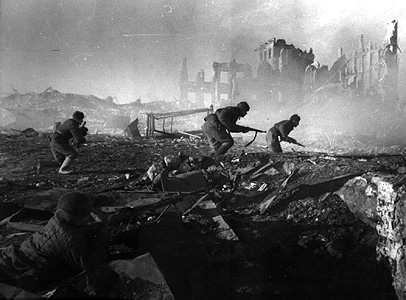
[thumbnail; click to see full size]
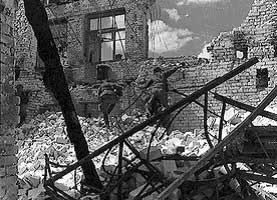
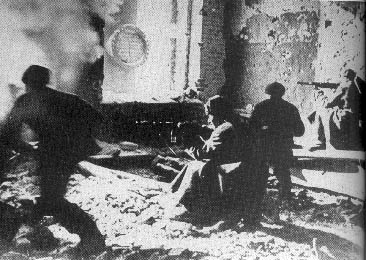
"We have fought during fifteen days for a single house. The front is a corridor between burnt-out rooms; it is the thin ceiling between two floors ... From story to story, faces black with sweat, we bombard each other with grenades in the middle of explosions, clouds of dust and smoke, heaps of mortar, floods of blood, fragments of furniture and human beings ... The street is no longer measured by meters but by corpses ... Stalingrad is no longer a town. By day it is an enormous cloud of burning, blinding smoke; it is a vast furnace lit by the reflection of the flames. And when night arrives, one of those scorching howling bleeding nights, the dogs plunge into the Volga and swim desperately to gain the other bank. The nights of Stalingrad are a terror for them. Animals flee this hell; the hardest stones cannot bear it for long; only men endure."
-- letter of a German lieutenant